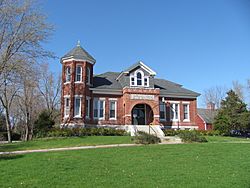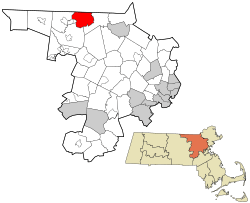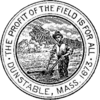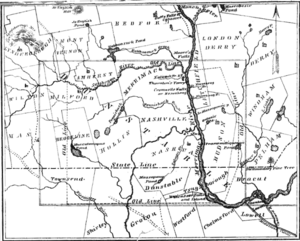Dunstable, Massachusetts facts for kids
Quick facts for kids
Dunstable, Massachusetts
|
||
|---|---|---|

The town hall
|
||
|
||
| Motto(s):
"The Profit of the Field is for All"
|
||

Location in Middlesex County in Massachusetts
|
||
| Country | United States | |
| State | Massachusetts | |
| County | Middlesex | |
| Settled | 1656 | |
| Incorporated | 1673 | |
| Government | ||
| • Type | Open town meeting | |
| Area | ||
| • Total | 16.7 sq mi (43.4 km2) | |
| • Land | 16.6 sq mi (42.9 km2) | |
| • Water | 0.2 sq mi (0.5 km2) | |
| Elevation | 224 ft (68 m) | |
| Population
(2020)
|
||
| • Total | 3,358 | |
| • Density | 202.3/sq mi (78.3/km2) | |
| Time zone | UTC-5 (Eastern) | |
| • Summer (DST) | UTC-4 (Eastern) | |
| ZIP code |
01827
|
|
| Area code(s) | 351 / 978 | |
| FIPS code | 25-17825 | |
| GNIS feature ID | 0618222 | |
| Website | http://www.dunstable-ma.gov/ | |
Dunstable is a small town in Middlesex County, Massachusetts, United States. It is located in the northeastern part of the state. In 2020, about 3,358 people lived here. Dunstable is known for keeping its rural, or countryside, feel, even as bigger towns grow around it.
Contents
What's in a Name? The Story of Dunstable
Dunstable gets its name from a town in Bedfordshire, England. There are a few interesting ideas about how the English town got its name.
The Legend of Dun
One old story says there was a thief named Dun. The King wanted to catch him. So, he put his ring on a post, daring Dun to steal it. Dun did steal the ring! It was later found at the house of Dun's mother. The thief was caught and punished. People say the new community was then named after him.
Other Name Ideas
Another idea is that the name comes from an old Anglo-Saxon phrase. It might mean "the boundary post of Duna." A third idea is that "Dun" means a hill, and "Staple" means a marketplace. So, it could mean "hill marketplace."
Dunstable's Journey Through Time
Dunstable was first settled by people in 1656. It officially became a town in 1673. It was probably named after Dunstable, England, because Edward Tyng, one of the first settlers, came from there.
The original Dunstable was much larger! In 1661, it was about 200 square miles. This huge area included parts of what are now several towns. These towns are Pepperell, Townsend, and Tyngsborough in Massachusetts. It also included Hudson, Nashua, and Hollis in New Hampshire.
Over time, as more people moved in, parts of Dunstable became their own separate towns. In 1740, the border between Massachusetts and New Hampshire was set. This placed the northern part of the original Dunstable (which is now Nashua) in New Hampshire. So, the Dunstable we know today is the southern part of that original large area.
Today, Dunstable has worked hard to keep its rural feel. It has avoided becoming too crowded or developed.
Where is Dunstable?
Dunstable is located in Middlesex County, Massachusetts. It covers about 16.7 square miles. Most of this area is land, with a small amount of water.
Dunstable shares its borders with several other towns:
- To the west: Pepperell
- To the south: Groton
- To the east: Tyngsborough
- To the north: Nashua and Hollis in New Hampshire
Who Lives in Dunstable?
In 2020, the town of Dunstable had a population of 3,358 people. The population has grown steadily over the years.
| Historical population | ||
|---|---|---|
| Year | Pop. | ±% |
| 1850 | 590 | — |
| 1860 | 487 | −17.5% |
| 1870 | 471 | −3.3% |
| 1880 | 453 | −3.8% |
| 1890 | 416 | −8.2% |
| 1900 | 427 | +2.6% |
| 1910 | 408 | −4.4% |
| 1920 | 353 | −13.5% |
| 1930 | 384 | +8.8% |
| 1940 | 447 | +16.4% |
| 1950 | 522 | +16.8% |
| 1960 | 824 | +57.9% |
| 1970 | 1,292 | +56.8% |
| 1980 | 1,671 | +29.3% |
| 1990 | 2,236 | +33.8% |
| 2000 | 2,829 | +26.5% |
| 2010 | 3,179 | +12.4% |
| 2020 | 3,358 | +5.6% |
| 2023* | 3,408 | +1.5% |
| * = population estimate. Source: United States Census records and Population Estimates Program data. |
||
The average age in Dunstable in 2000 was 37 years old. About 31% of the people were under 18 years old. This shows that many families with children live in the town.
Dunstable's Weather
Dunstable, Massachusetts, has a typical New England climate.
- Cold Days: Temperatures usually drop below 50 degrees Fahrenheit for about 195 days each year.
- Rain and Snow: The town gets about 44.2 inches of rain each year. Snow covers the ground for about 68 days a year. This means you can expect snowy winters!
- Humidity: The air is usually not too humid. It is below 60% humidity for about 25 days a year.
Schools in Dunstable
Dunstable is part of the Groton-Dunstable Regional School District. This district serves both Dunstable and Groton.
District Schools
- Boutwell School
- Swallow Union Elementary School
- Florence Roche Elementary School
- Groton-Dunstable Regional Middle School
- Groton-Dunstable Regional High School
Other Public Schools
- Greater Lowell Technical High School – This is a public technical high school located in Tyngsborough. It offers special training in various trades.
Fun Places to Visit in Dunstable
Dunstable has several interesting places to explore.
- The Little Red Schoolhouse: This historic building is on Route 113. It was originally from Tyngsborough. Students often visit it to experience what a school day was like long ago. An annual Strawberry Festival is also held here. The local Boy Scout Troop 28 also hosts a Mother's Day pancake breakfast.
- Sarah R. S. Roby Town Hall: Located at 511 Main Street (Route 113), this building was built in 1909. It was updated in 2003. Most town offices are here. It also has rooms for meetings and events.
- The Town Commons: This open area is across from the Town Hall on Route 113. Many town events happen here. These include summer "Concerts on the Common" and the Grange Fair in August. It is also the site for the annual auto show in Dunstable.
- Dunstable Evangelical Congregational Church (DECC): This church is at 518 Main Street, next to the Town Commons. The church group started here in 1831, but the current building is from the early 1900s. It is the only church in town, so people often just call it "the Dunstable Church."
- Dunstable Free Library: You can find the library at 588 Main Street. Besides books, magazines, and movies, it has activities for children. It also holds historic items, like old typewriters. Town elections are held here too.
- Blanchard Hill: This is a 39-acre conservation area. It used to be a ski resort. Now it's a great place to enjoy nature.
Famous People from Dunstable
Many interesting people have connections to Dunstable:
- Isaac Fletcher (1784–1842): He was a United States Representative from Vermont.
- Colleen Green (born 1984): An independent musician.
- Amos Kendall (1789–1869): He served as the United States Postmaster General under President Andrew Jackson.
- Amos Lawrence (1786–1852): A well-known merchant and someone who gave a lot to charity.
- John Lovewell (1691–1725): A Colonial militia captain who fought in a war called Father Rale's War.
- Samuel Parris (1653–1720): A Puritan minister during the Salem witch trials.
- Ellen Swallow Richards (1842–1911): A chemist and the first woman to be accepted into MIT (Massachusetts Institute of Technology).
See also
 In Spanish: Dunstable (Massachusetts) para niños
In Spanish: Dunstable (Massachusetts) para niños



